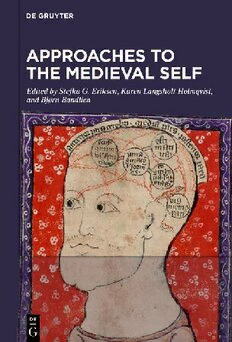
Approaches to the Medieval Self: Representations and Conceptualizations of the Self in the Textual and Material Culture of Western Scandinavia, c. 800–1500 PDF
Preview Approaches to the Medieval Self: Representations and Conceptualizations of the Self in the Textual and Material Culture of Western Scandinavia, c. 800–1500
ApproachestotheMedievalSelf Approaches to the Medieval Self Representations and Conceptualizations of the Self in the Textual and Material Culture of Western Scandinavia, c. 800–1500 Edited by Stefka G. Eriksen, Karen Langsholt Holmqvist, and Bjørn Bandlien ISBN978-3-11-065555-1 e-ISBN(PDF)978-3-11-065558-2 e-ISBN(EPUB)978-3-11-066476-8 https://doi.org/10.1515/9783110655582 ThisworkislicensedunderaCreativeCommonsAttribution-NonCommercial-NoDerivatives4.0 InternationalLicense.Fordetailsgotohttp://creativecommons.org/licenses/by-nc-nd/4.0/. LibraryofCongressControlNumber:2020938218 BibliographicinformationpublishedbytheDeutscheNationalbibliothek TheDeutscheNationalbibliothekliststhispublicationintheDeutscheNationalbibliografie; detailedbibliographicdataareavailableontheInternetathttp://dnb.dnb.de. ©2020StefkaG.Eriksen,KarenLangsholtHolmqvistandBjørnBandlien,publishedby WalterdeGruyterGmbH,Berlin/Boston Thebookispublishedopenaccessatwww.degruyter.com. Coverimage:Trilingualcompendiumoftexts,MSGg1.1;490v,reproducedbykind permissionoftheSyndicsofCambridgeUniversityLibrary. Typesetting:IntegraSoftwareServicesPvt.Ltd. Printingandbinding:CPIbooksGmbH,Leck www.degruyter.com Acknowledgments This book is one of the main results of the research project “The Self in Social Spaces,” funded by the Young Research Talents program at the Norwegian ResearchCouncil(2016–2020).ManythankstotheNorwegianResearchCouncil forgenerousfunding. Thebook isthe endproductofalong,creative processthatstartedevenbe- foretheprojectwasfunded.ThePIoftheproject,StefkaG.Eriksen,wouldliketo thankherformercolleaguesatInstituteforLinguisticsandScandinavianStudies, attheUniversityofOslo,whoprovidedastimulatingatmospherefordevelop- ing this project. Eriksen would also like to thank Ian P. Wei, Kathrine Smith, Rita Copeland, Lena Liepe, Ármann Jakobsson, and Sverrir Jakobsson, for in- spiring discussions and feedback to an early version of the project at a semi- narinReykjavík,Iceland,2014. ThebookisbasedonaconferenceorganizedbytheeditorsinJune2018,in Oslo. In addition to the authors contributing to the book, the conference was attended by other scholars, who for various reasons did not contribute to the book. Thank you for participating and contributing to the discussions, Line Cecilie Engh, Jan Erik Rekdal, Margrete Syrstad Andås, Anders Jarlert, Mille Stein, Kaja Merete Hagen, and Terje Gansum. We are also grateful to Kristin Bakken and Ellen Hole, General Director and Head of Department at the NorwegianInstituteforCulturalHeritage,forbeingsupportiveandenthusiastic toourworkthroughouttheproject,forparticipatingattheconferencein2018, andforprovidingfinancialsupportfortheOA-publication. ManythanksgotoMariaZucker,fromDeGruyter,whoattendedtheconfer- encein2018andwasgenerouswithadvicesandsuggestionsaboutthepublica- tion from the very start. During its various stages, the publication has been followed up by Elisabeth Kempf, Laura Burlon, and Julia Sjöberg, from De Gruyter;manythanksfortheirhelpandassistancethroughouttheprocesstoo. Toourauthors,manythanksforexcellentandinspiringcooperation.Many thanks to the peer-reviewers for constructive feedback to the articles in the book. And last but not least, many thanks to Philly Rickets for her precision andthoroughnesswhencopy-editingthebookandwhenpreparingtheindex. Oslo,20.April2020 StefkaG.Eriksen,KarenLangsholtHolmqvist,BjørnBandlien OpenAccess.©2020StefkaG.Eriksenetal.,publishedbydeGruyter. Thisworkis licensedunderaCreativeCommonsAttribution-NonCommercial-NoDerivatives4.0InternationalLicense. https://doi.org/10.1515/9783110655582-202 Contents Acknowledgments V StefkaG.Eriksen,KarenLangsholtHolmqvist,andBjørnBandlien ApproachestotheSelf–FromModernityBacktoVikingandMedieval Scandinavia 1 DavidGaryShaw TheNetworkedHistoricalSelf,TravelingVersion 21 StefkaG.EriksenandMarkTurner CognitiveApproachestoOldNorseLiterature 41 FrancisF.Steen ThePrecariousSelf 63 BjørnBandlien MultipleSpaces,MultipleSelves?TheCaseofKingSverrir ofNorway 81 TorfiH.Tulinius TheMedievalSubjectandtheSagaHero 101 KarlG.Johansson TheSelfishSkald:TheProblematicCaseoftheSelfofthePoet ofSonatorrek 123 StefkaG.Eriksen MedievalPage-turners:InterpretingRevengeinNjálssagainReykjabók (AM4684to)andMöðruvallabók(AM132fol.) 145 Ole-AlbertRønningNordby TheSelfinLegalProcedure:Oath-TakingasIndividualisminNorwegian MedievalLaw 177 RakelIglandDiesen TheAgencyofChildreninNordicMedievalHagiography 195 VIII Contents EliseNaumann Food,EverydayPractice,andtheSelfinMedievalOslo:AStudy ofIdentitiesBasedonDietaryReconstructionsfromHumanRemains 213 SarahCroix Identifying“Occasions”oftheSelfinViking-AgeScandinavia: TextileProductionasGenderedPerformanceinItsSocialandSpatial Settings 235 EgilLindhartBauer Self-expressionthroughEponymousTenementPlotsinMedieval Oslo 255 LineM.Bonde SearchingfortheSelfinDanishTwelfth-CenturyChurches: APraxeologicalExperiment 279 KarenLangsholtHolmqvist TheCreationofSelvesasaSocialPracticeandCognitiveProcess: AStudyoftheConstructionofSelvesinMedievalGraffiti 301 StefkaG.Eriksen,KarenLangsholtHolmqvist,andBjørnBandlien TheSelfinVikingandMedievalScandinavia,andBeyond: BetweentheMaterial,theSocial,andtheCognitive 325 Index 333 Stefka G.Eriksen, Karen LangsholtHolmqvist, and BjørnBandlien – Approaches to the Self From Modernity Back to Viking and Medieval Scandinavia Abstract:Inthisarticletheeditorsofthebookaccountforthebook’smainaims, namelytodiscussvariousmodesofstudyinganddefiningtheselfandtoinvesti- gate the various processes and practices that selves in Viking and medieval Scandinaviaengagedwith.Inthebook,thesetworesearchquestionsaredis- cussed based on various representations and conceptualizations of the self in textual, historical, art-historical, and archaeological sources from western Scandinavia.Thus,thebookaimstocontributeto(1)studiesoftheselfinViking andmedievalScandinavia;(2)studiesofthemedievalselfingeneral;and(3)the- oretical discussions on the interconnections between cognition, materiality of culturalexpressions,discoursesandpractices.Thisintroductoryarticleaccounts forthehistoriographiesofthesefieldsandthestructureofthebook. Keywords: agency, blending theory, choosing / choice-making, cognitive the- ory, cultural theory, homo economicus, homo sociologicus, practice theory, ra- tionalchoicetheory,socialtheory,wayfinding This book has two main aims. First, the book will discuss various modes of studying and defining the medieval self. This will encompass a wide range of source material from Scandinavia, c. 800–1500, such as archaeological, archi- tectural and artistic, documentary and literary sources, and runic inscriptions. Thesecondmainaimofthebookwillbetodiscusswhatprocessesandpracti- ces the self engaged with in this cultural context, by studying various textual andmaterialrepresentationsandconceptualizationsoftheself. The first question that probably occurs to most readers of this book is: Whatistheself?Thebookasawholewillnotseektogiveaunifiedanswerto thisquestionasitwillnotdeployasingletheoreticalandmethodologicalap- proach.Rather,theindividualarticleswilltakeondifferentapproachestothe self,inspiredbytheoriessuchasculturaltheory,practicetheory,orcognitive theory, or prioritizing close reading of the empirical material. The book does StefkaG.Eriksen,KarenLangsholtHolmqvist,NorwegianInstituteforCulturalHeritage Research BjørnBandlien,UniversityofSouth-EasternNorway OpenAccess.©2020StefkaG.Eriksenetal.,publishedbyDeGruyter. Thisworkis licensedunderaCreativeCommonsAttribution-NonCommercial-NoDerivatives4.0InternationalLicense. https://doi.org/10.1515/9783110655582-001
